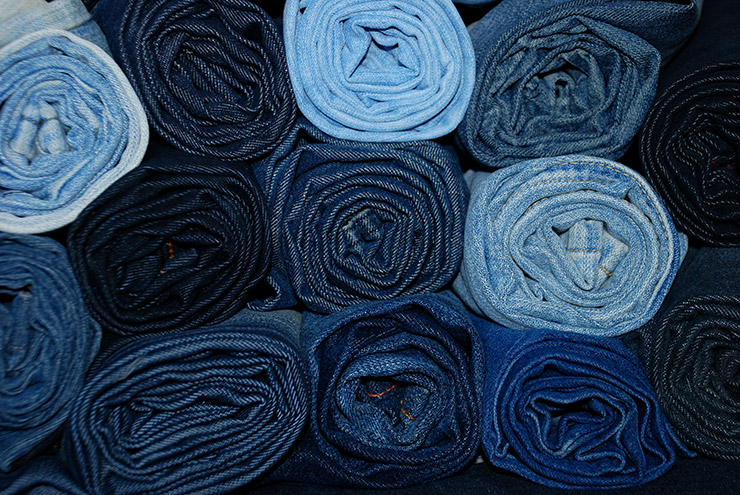Back to the future – denim brands turn to Polygiene as the industry begins a new chapter
With the booming second-hand fashion market and growing desire for items that last longer, denim is entering a new era, and the Swedish firm Polygiene is playing a key role.

In 2019, the global market for second hand clothes expanded 21 times faster than that for new apparel1 and this surging demand has been further accelerated by the impact of the pandemic.
The US second hand fashion market is now expected to more than triple in value in the next 10 years – from US$28 billion in 2019 to US$80 billion in 2029, according to a report from ThredUp published in 20212.
At the same time, consumers have expressed a desire for more durable garments. In a poll carried out by McKinsey & Company in April 20203, two-thirds of surveyed consumers said that it has become even more important to limit impacts on climate change, while 88% of respondents believed more attention should be paid to reducing pollution.
The poll of more than 2,000 UK and German consumers found that as a result of the pandemic, 65% of respondents were planning to purchase more durable fashion items, with 71% planning to keep the items they already have for longer. Additionally, 57% of respondents said they were willing to repair items to prolong usage.
As consumers re-evaluate their wardrobes, the unique qualities of denim – in particular its durability – are more important than ever. Yet to fully understand the fabric’s special qualities, and the priorities for the denim industry today, it is useful to look right back to the beginning of its long and rich history.
Ancient Peru
The telling of denim’s story usually begins in the 18th century in the French city of Nimes, where tailors began weaving cotton together in a twill weave to create a reinforced fabric, with the weft passing under two or more warp threads. The outer warped threads were dyed with indigo and the inner weft thread was left in the original white colour. The name ‘denim’ derives from ‘de Nimes’ meaning ‘from Nimes’.
While this account of denim’s development in Europe is widely accepted, research over recent years has shown that the origins of denim can be traced back much further – by more than 6,000 years to the ancient Americas. In 2016, scientists discovered Andean cotton fabric from Peru with traces of Indigo dye4.
One of the fabrics discovered was a cotton plain weave with indigo blue yarns forming a warp stripe on one edge and weft bands with a float patterning.
This made it the earliest known use of indigo in the world, derived most likely from Indigofera spp. native to South America. This predates by around 1,500 years the earliest reported use of indigo in the Old World, from Fifth Dynasty Egypt [ca. 4400 BP (before present)].
Latin America went on to become a key centre of indigo production, with plantations set up across Spanish South America, as well as British Colonies of the New World like Jamaica and North Carolina.
India also played an important role in the development of denim. A rich blue dye could be extracted from the variety of indigo plant found in India (Indigofera tinctoria). Harappans, from Harappa in Punjab, first started making the dye around 5,000 years ago. The ancient Greeks called it ‘indikon’, meaning ‘from India’, which the Romans copied, and it became ‘indicum’ in Latin, eventually evolving to ‘indigo’ in English.
While other varieties of indigo were found in various tropical countries, thanks to this discovery India arguably became the indigo centre of the world around this time.
The evolution of denim
The natural indigo dye created in these ancient times was key to the success of denim as it evolved during the industrial revolution in Europe and then America. The twill weave developed in Nimes, which used indigo to give the fabric a unique blue colour on one side, with white on the other, was used widely across Europe.
This European fabric went on to become the denim jeans we are familiar with today after the German immigrant Levi Strauss moved to San Francisco during the 1853 California ‘gold rush’ to start a Western branch of his family’s dry goods business.
Strauss was commissioned by a gold mining company to create trousers which were strong and could withstand hard work. As well as the sturdiness of the fabric, it was also popular for workwear as the smell of the natural indigo dye helped repel mosquitos.
In the early 20th century, denim was adopted as the preferred workwear fabric choice for western cowboys, miners and farmers in the US. After Levi’s & Strauss patented the metal rivets to make them more hard-wearing, they began producing the iconic denim blue trousers that became a common feature among working men. This classic symbol of the American West then went on to become the wardrobe staple that it is today.
Extending a garment’s life
With the increasing demand for long-lasting, sustainable clothing and the booming second-hand fashion market today, denim is now entering a new chapter as consumers seek products that last for many years and can be passed on to the next generation.
This explains why a growing number of brands and manufacturers are looking for new ways to preserve and enhance the natural qualities of denim to create products with an ever longer life.
One particularly effective, but very simple way for consumers to extend the life of their clothes, such as denim jeans, is by washing them less frequently. The fewer times a product goes through the laundry, the longer it will last.
 Technology from the Swedish firm Polygiene has been developed to help brands and consumers make this happen. The brand’s treatments ensure that garments stay fresh and last longer by controlling odor in textiles, allowing consumers to significantly reduce the number of times they wash a product – to, quite simply, wear more and wash less.
Technology from the Swedish firm Polygiene has been developed to help brands and consumers make this happen. The brand’s treatments ensure that garments stay fresh and last longer by controlling odor in textiles, allowing consumers to significantly reduce the number of times they wash a product – to, quite simply, wear more and wash less.
The importance of this in reducing the environmental impact of clothing was highlighted in the Fashion on Climate report from McKinsey & Company published in 20205. This study examined how the fashion industry can move from producing 2.7 billion tonnes of emissions in 2030 if no further action is taken to 1.1 billion tonnes by this date – putting it in line with the efforts needed to limit global warming to 1.5°C compared to pre-industrial levels.
The analysis found that under this scenario, 61% of emissions savings would come from upstream production, with 21% coming from usage & end-of-use and 18% from brand operations.
Because Polygiene extends the life of clothing due to less frequent washing, it not only helps reduce emissions from the usage & end-of-use phase, but also from upstream production – by far the biggest contributor to emissions – as fewer garments need to be produced.
This is further backed up by research completed in Sweden6 which found that using garments twice as many times in their original purchase form cuts the climate impact by almost 50%. This reduction is mainly due to fewer new clothing items needing to be made.
Premium brands
Polygiene’s three main technologies are Polygiene BioStatic™, an antimicrobial technology that inhibits the growth of odor-causing bacteria created from sweat, heat or humidity; Polygiene OdorCrunch™, which removes body odors and any environmental odors such as cooking fumes or cigarette smoke; and Polygiene ViralOff™, an antimicrobial treatment that reduces over 99% of microbes in a treated material or product.
More than 300 global premium brands have now chosen to work with the technology brand for their products. This includes a growing number from the denim sector, with Italian brand Diesel and UK label Hiut Denim among the latest.
Diesel introduced new denim styles featuring Polygiene OdorCrunch™ and Polygiene ViralOff™ technologies in its Spring/Summer 2021 ranges. Then in November 2021 it launched its new Second Hand collection, comprising garments brought back into store by consumers and then given a second life, with the same combination of Polygiene treatments being used. Hiut Denim, set up in 2012 in the town of Cardigan in Wales, a place with a rich heritage of denim production, is committed to producing jeans of exceptional quality and makes just 150 pairs a week. The brand shot to prominence in 2018 when Meghan Markle was spotted in a black pair of Hiut jeans, creating a big buzz and a backorder waiting list for three months. The company has opted to use Polygiene BioStatic™ technology to help their jeans stand the test of time.
 These brands, along with material partners such as Pakistan’s Naveena Denim Mills and Vicunha in Brazil, have found that the technology brand’s finishes do not affect the natural indigo color in denim, keeping this vital aspect of the garment unchanged while helping their products last longer and bring a whole new sustainability opportunity.
These brands, along with material partners such as Pakistan’s Naveena Denim Mills and Vicunha in Brazil, have found that the technology brand’s finishes do not affect the natural indigo color in denim, keeping this vital aspect of the garment unchanged while helping their products last longer and bring a whole new sustainability opportunity.
So, as more denim producers utilize these new technologies, the company is playing an increasingly important role in the industry’s attempt to alter the perception of denim products – as garments to treasure and wear for years to come rather than throwaway items.
This aim mirrors the brand’s own stated mission to “change the way we view clothes – from fast consumables to durables.” We can therefore expect more denim players to turn to Polygiene in the years to come.
References
2. https://www.thredup.com/resale/#size-and-impact
4. https://www.science.org/doi/10.1126/sciadv.1501623
6. Sandin, G., Roos, S., Spak, B., Zamani, B. and Peters, G., 2019, Environmental assessment of Swedish clothing consumption: Six garments – sustainable futures (https://www.researchgate.net/publication/335653501_Environmental_assessment_of_Swedish_clothing_consumption_-_six_garments_sustainable_futures); accessed 10 March 2020).













